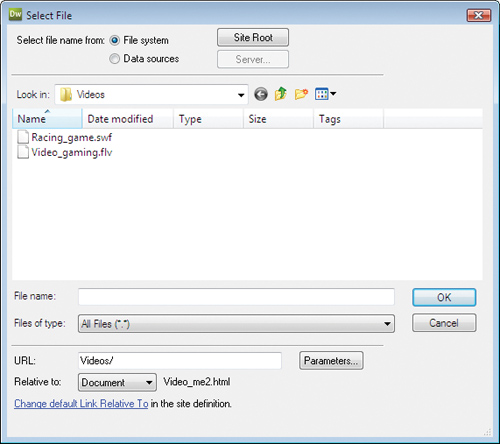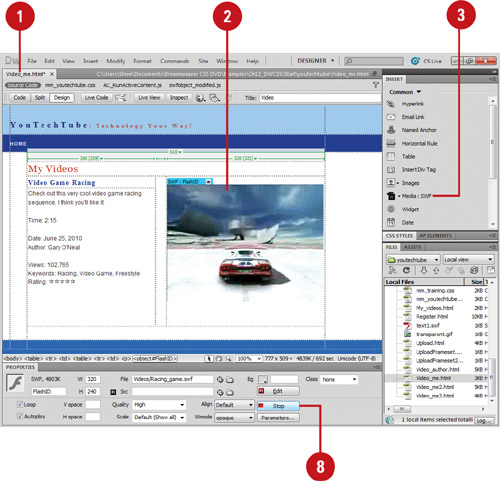Introducing Flash File Types
Adobe
Flash allows you to create a variety of file types—FLA, SWF, SWT, SWC,
and FLV—for different purposes. The Flash file (.fla) is the source file
format for the Adobe Flash program. This file format cannot be opened
in Dreamweaver; you can only open this file format in Flash. You use the
source Flash file (.fla) to create the other Flash file formats.
You can insert the following Flash file formats into a Web page in Dreamweaver:
Flash SWF (.swf). This file format creates a compressed movie of the Flash (.fla) file.
Flash Template (.swt). This file format creates a SWF file you can customize with your own text or links, such as a Flash button or Flash text.
Flash element file (.swc). This file format creates a SWF file you can create Rich Internet applications with customizable parameters.
Flash Video file (.flv). This file format creates a video file with audio and video encoding you can play in the Flash Player.
If you have Adobe FlashPaper 2
or later, you can convert printable files into Flash documents or Adobe
PDF files, which you can insert into Dreamweaver.
You don’t need to have Adobe
Flash installed on your computer to insert these file formats into
pages in Dreamweaver. However, when you do have Adobe Flash installed on
your computer, you can make changes to the source Flash files (.fla),
and then create the file format you want to use in Dreamweaver.
You can use the Media
button on the Common tab on the Insert panel, or use the Media submenu
on the Insert menu to add different Flash file types into a page in
Dreamweaver.

Inserting a Flash or Shockwave Movie
Flash
can create all types of multimedia content. From a lead-in page (called
a splash screen), to animated banners, to cool-looking, as well as
functional menus, Flash is leading the way in Web based multimedia
content. Flash utilizes resolution independent vector graphics,
streaming audio, and even raster images to create fast-loading Web
content. Flash is so popular that according to the World Wide Web
Consortium, over 90 percent of people surfing the Web have browsers that
can view Flash content. And since version 4, Flash has its own
scripting language to help designers take designs into the Stratosphere.
Dreamweaver does not create Flash movies; however, it makes it very
easy to add them to your Web pages. Once inserted, the Properties panel
will give you access to controls that instruct the browser exactly what
to do when the movie loads.
Insert and Preview a Flash or Shockwave Movie
1. Open the Web page you want to insert a movie.
 |
2. Click to place the insertion point where you want the movie.
|
3. Insert the movie using one of the following options:
- Click the Common tab on the Insert panel, click the Media arrow button, and then click SWF or Shockwave.
- Click the Insert menu, point to Media, and then click SWF or Shockwave.
|
4. Navigate to the location with the Flash file (extension .swf or .swc), and then select it.
|
5. Click OK.
|
6. Enter the accessibility attributes (title, access key, and tab index) you want.
|
7. Click OK.
|
8. To view the Flash content, click the Flash placeholder icon, and then click the Play button in the Properties panel to begin the preview. Click Stop to end the preview. |